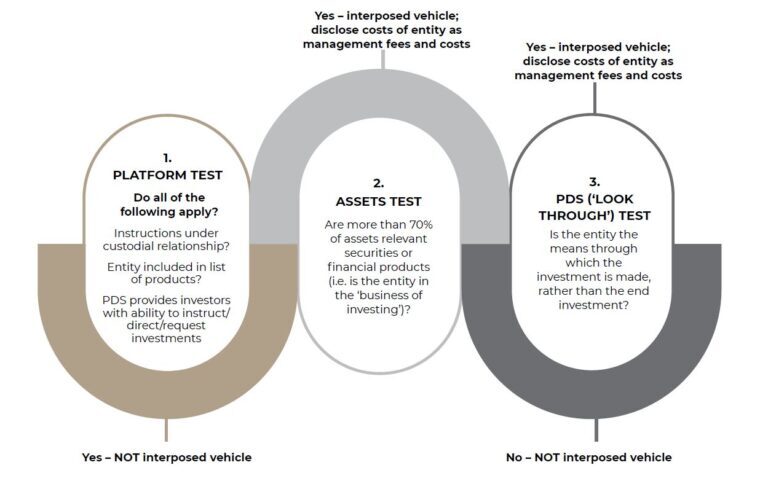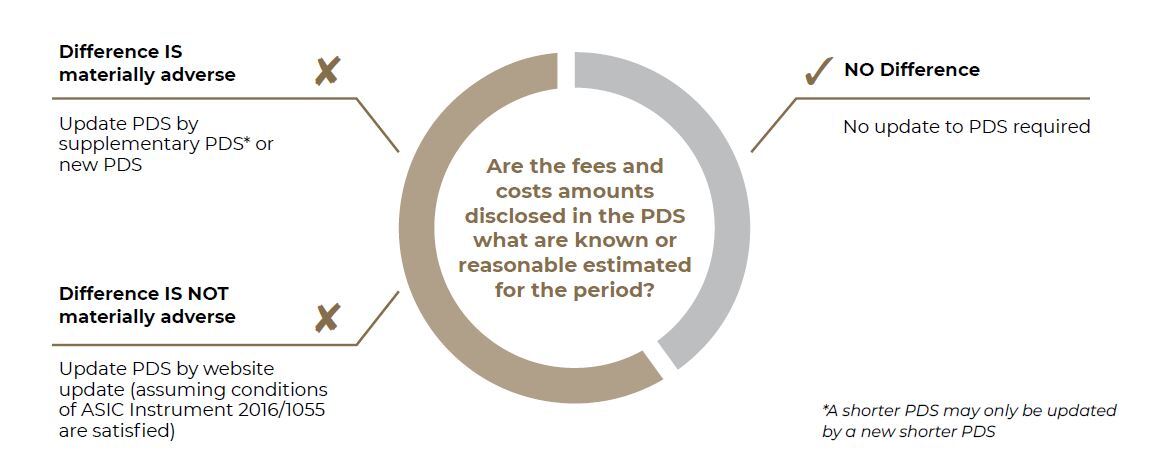Funds of funds
Master/feeder structures
Holding companies
Listed MIS, LICs, EFTs, hedge funds
Life companies
Trusts
Unlisted funds
Partnerships
Listed and unlisted REITs where these are not considered the ‘property’ itself
RG 97: Updating your disclosure documents – things you need to know
A new fees and costs disclosure regime commences for product disclosure statements (PDSs) in the market on and from 30 September 2022.
Issuers must review their PDSs to ensure compliance with the following:
PDS | Shorter PDS/APDS |
|---|---|
| Part 7.9 of the Corporations Act | Part 7.9 of the Corporations Act (as modified) |
| Schedule 10 to the Corporations Regulations | Schedule 10E to the Corporations Regulations |
| ASIC Instrument 2019/1070 | ASIC Instrument 2019/1070 |
| ASIC RG 97 | ASIC RG 97 |
There are new prescribed templates for the fees and costs table and the annual example of fees and costs.
A new concept of ‘cost of product’ has been introduced. The ‘cost of product’ comprises contribution fees, management fees and costs, performance fees, and transaction costs. ‘Cost of product’ information replaces the old ‘indirect cost ratio’ or ‘ICR’.
‘Indirect costs’ remain and are included in the definition of ‘management fees and costs’.
The definition of ‘indirect costs’ has been expanded.
‘Indirect costs’ means -
‘any amount that a responsible person knows, or reasonably ought to know or, where this is not the case, may reasonably estimate has reduced or will reduce (as applicable) whether directly or indirectly the return on the product or option that is paid from or reduces the amount or value of—
the income of or the property attributable to the product or option, or
the income of or property attributable to an interposed vehicle in or through which the property attributable to the product or option is invested.’
‘Indirect costs’ also means -
‘any amount that satisfies both of the following:
the amount is paid or payable by or on behalf of a person who may make payments that form part of the return on, or the value of, the product or option whether directly or through an interposed vehicle,
payment of the amount is a benefit that increases the returns or value of the product or option or provides a benefit to the issuer in relation to the product or option that is retained by the issuer.’
Assets and PDS tests
The interposed vehicle test is the same.
An interposed vehicle is a body, trust or partnership that is not excluded under the platform test and meets either the ‘assets test’ or the ‘PDS test’.
An interposed vehicle is any holding vehicle, or entity that would not be considered the ultimate reference asset.

Listed securities themselves, including listed REITs and listed infrastructure entities where they form part of an equities portfolio
Operating entities
Derivatives – indirect costs include costs associated with over-the-counter derivatives that are used as a means of achieving the investment strategy (as compared with used to manage the risks associated with the investment strategy). The intention is to capture costs paid to compensate a counter-party for managing positions by holding assets; e.g., fees paid to brokers and advisors, estimates of margins, etc.
Income sharing arrangements – fees and costs cannot be reduced or offset through income sharing arrangements. For example, if a fund generates income through lending securities and the custodian retains a portion of this income as payment for providing the lending service, then this portion is a cost and should be included in the ‘management fees and costs’ amount.
Fees and costs paid by third parties – if these amounts would have otherwise been charged to, or paid from, the fund, then they need to be disclosed as management fees and costs.
Transaction costs and performance fees
Transaction costs – Transaction costs no longer include borrowing costs or property operating costs. However, you now need to include transaction costs as a separate line item in the fees and costs summary and the example of annual fees and costs. Transaction costs are included in the calculation of the cost of product.
Performance fees – You now need to include performance fees as a separate line item in the fees and costs summary and the example of annual fees and costs. Any performance fees charged are included in the calculation of the cost of product.
Ensuring your PDS is up-to-date
After the end of each financial year issuers must review their PDSs to ensure the amounts disclosed are consistent with what is known or reasonably estimated for the period. ASIC expects most PDSs will be ‘rolled’ each year to ensure the PDS is up to date at all times and is not misleading.
